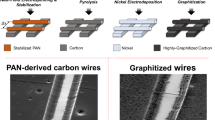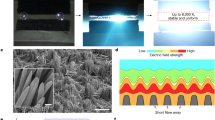Abstract
Carbon nanotubes, first identified by Iijima1, require for their production a source of elemental carbon and a transfer of energy that is specific to the type of source and the growth environment. Methods developed so far involve arc discharge2, and vaporization using laser3,4, pyrolysis5,6 and chemical vapour deposition of hydrocarbons7. Here, we show growth of carbon nanofibres from radio-frequency plasma-enhanced chemical vapour deposition at room temperature, which was made possible by substituting the thermal energy requirements for the growth with plasma decomposition of methane on the Ni catalyst. Electron microscopy analysis provides evidence for a 'tip' growth model8, with the Ni catalyst particle attached to the tip of the nanofibre. Energy-filtered imaging shows the Ni catalyst has a surface layer rich in carbon, consistent with the formation of a eutectic Ni–C droplet as a nucleation site for the carbon nanofibres9, so that the carbon diffuses across the surface. The reduced distortion of the catalyst particles at low temperatures leads to a more uniform growth of the carbon nanofibres over large areas. The lower growth temperature allows for the removal of the silicon dioxide barrier layer associated with catalytic growth, and should allow in situ growth of nanofibres on relatively large areas of temperature-sensitive substrates, such as plastics, organics and even paper.
This is a preview of subscription content, access via your institution
Access options
Subscribe to this journal
Receive 12 print issues and online access
$259.00 per year
only $21.58 per issue
Buy this article
- Purchase on Springer Link
- Instant access to full article PDF
Prices may be subject to local taxes which are calculated during checkout




Similar content being viewed by others
References
Iijima, S. Helical microtubules of graphitic carbon. Nature 354, 56–58 (1991).
Ebbesen, T.W. & Ajayan, P.M. Large-scale synthesis of carbon nanotubes. Nature 358, 220–222 (1992).
Thess, A. et al. Crystalline ropes of metallic carbon nanotubes. Science 273, 483–487 (1996).
Rao, A.M. et al. Diameter-selective Raman scattering from vibrational modes in carbon nanotubes. Science 275, 187–191 (1997).
Endo, M. et al. The production and structure of pyrolytic carbon nanotubes (PCNTs). J. Phys. Chem. Solids 54, 1841–1848 (1993).
Amelinckx, S. et al. A formation mechanism for catalytically grown helix-shaped graphite nanotubes. Science 265, 635–639 (1994).
Endo, M. Grow carbon fibres in the vapour phase. Chemtech 18, 568 (1988).
Baker, R.T.K. & Harris, P.S. in Chemistry and Physics of Carbon Vol. 14 (eds Walker, P.L. Jr. & Thrower, P.A.) 83 (Marcel Dekker, New York, 1978).
Kuznetsov, V.L., Usoltseva, A.N., Chuvilin, A.L., Obraztsova, E.D. & Bonard, J.-M. Thermodynamic analysis of nucleation of carbon deposits on metal particles and its implications for growth of carbon nanotubes. Phys. Rev. B 64, 235401 (2001).
Rodriguez, N.M. A review of catalytically grown carbon nanofibres. J. Mater. Res. 8, 3233–3250 (1993).
Ren, Z.F., Huang, Z.P., Xu, J.W., Wang, J.H., Bush, P., Siegal, M.P. & Provencio, P.N. Synthesis of large areas of well-aligned carbon nanotubes on glass. Science 282, 1105–1107 (1998).
Chhowalla, M. et al. Growth process conditions of vertical aligned carbon nanotubes using plasma enhanced chemical vapour deposition. J. Appl. Phys. 90, 5308–5317 (2001).
Merkulov, V.I. et al. Controlled alignment of carbon nanofibers in a large-scale synthesis process. Appl. Phys. Lett. 80, 4816–4818 (2002).
Qin, L.C., Zhou, D., Krauss, A.R. & Gruen, D.M. Growing carbon nanotubes by microwave plasma-enhanced chemical vapor deposition. Appl. Phys. Lett. 72, 3437–3439 (1998).
Bower, C., Zhu, W., Jin, S. & Zhou, O. Plasma-induced alignment of carbon nanotubes. Appl. Phys. Lett. 77, 830–832 (2000).
Okai, M., Muneyoshi, T., Yaguchi, T. & Sasaki, S. Structure of carbon nanotubes grown by microwave-plasma-enhanced chemical vapour deposition. Appl. Phys. Lett. 77, 3468–3470 (2000).
Endo, M. et al. Raman spectroscopic characterization of submicron vapour-grown carbon films and carbon nanofibres obtained by pyrolysing hydrocarbons. J. Mater. Res. 14, 4474–4477 (1999).
Endo, M. et al. Structure characterization of cup-stacked-type nanofibres with an entirely hollow core. Appl. Phys. Lett. 80, 1267–1269 (2002).
Bower, C., Zhou, O., Zhu, W., Werder, D.J. & Jin, S. Nucleation and growth of carbon nanotubes by microwave plasma chemical vapour deposition. Appl. Phys. Lett. 77, 2767–2769 (2000).
Baker, R.T.K., Barber, M.A., Harris, P.S., Feates, F.S. & Waite, R.J. Nucleation and growth of carbon deposits from the Ni catalysed decomposition of acetylene. J. Catalys. 26, 51–62 (1972).
Ebbesen, T.W. et al. Electrical conductivity of individual carbon nanotubes. Nature 382, 54–56 (1996).
Wong, E.W., Sheehan, P.E. & Lieber, C.M. Nanobeam mechanics: Elasticity, strength, and toughness of nanorods and nanotubes. Science 277, 1971–1975 (1997).
Endo, M. et al. in Carbon Nanotubes (eds Endo, M., Iijima, S. & Dresselhaus, M.) 1–9 (Pergamon, New York 1996).
Acknowledgements
The authors are grateful to G. Y. Chen and H. Herman of the University of Surrey for the Raman analysis.
Author information
Authors and Affiliations
Corresponding author
Ethics declarations
Competing interests
The authors declare no competing financial interests.
Rights and permissions
About this article
Cite this article
Boskovic, B., Stolojan, V., Khan, R. et al. Large-area synthesis of carbon nanofibres at room temperature. Nature Mater 1, 165–168 (2002). https://doi.org/10.1038/nmat755
Received:
Accepted:
Published:
Issue Date:
DOI: https://doi.org/10.1038/nmat755
This article is cited by
-
Fabrication of crystalline submicro-to-nano carbon wire for achieving high current density and ultrastable current
Microsystems & Nanoengineering (2022)
-
Decoupling electrolytes towards stable and high-energy rechargeable aqueous zinc–manganese dioxide batteries
Nature Energy (2020)
-
Red-phosphorus-impregnated carbon nanofibers for sodium-ion batteries and liquefaction of red phosphorus
Nature Communications (2020)
-
Carbon nanotubes: synthesis, properties and engineering applications
Carbon Letters (2019)
-
Multi-Functional Carbon Fibre Composites using Carbon Nanotubes as an Alternative to Polymer Sizing
Scientific Reports (2016)



